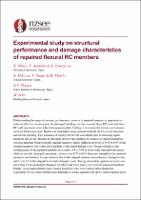Experimental study on structural performance and damage characteristics of repaired flexural RC members

Download
Date
2023-04-19Authors
Miura, Kota
Mikawa, Akira
Nagai, Tomoki
Shegay, Alex
Anabuki, Takuya
Yonezawa, Kenji
Maeda, Masaki
Seki, Matsutaro
Metadata
Show full item recordAbstract
Understanding the expected seismic performance recovery of repaired members is important to make an effective recovery plan for damaged buildings. In this research, three RC beam and three RC wall specimens were subjected to pseudo-static loading to determine the seismic performance recovery following repair. Repair was undertaken using general methods such as epoxy injection and mortar patching. Two scenarios of damage level were considered prior to initiating repair: moderate and severe. Results of this study showed that spalling of concrete in repaired members was less than that observed in the original members. Initial stiffness recovery of 50% to 60% of the original members was achieved, regardless of the initial damage level. Secant stiffness at the yielding point of the repaired members fully recovered in moderately damaged specimens while in severely damaged specimens recovery was 80% to 90%. Structural strength of the repaired members was found to be equivalent to that of the original members in moderately damaged cases and 10% higher than the original in severely damaged cases. Energy absorption capacity recovery was more than 80% in moderately damaged members and more than 40% in severely damaged members. Finally, crack characteristics were studied based on visual observations taken during the experiment. It was observed that some of cracks injected with epoxy resin reopened upon loading, which explained the low recovery of initial stiffness. Crack width data showed that wider cracks are generally less likely to reopen following repair because of better epoxy penetration.
